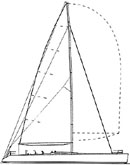Pyewacket
Racer
Well, according to early race results you can't lose. The first race for Pyewacket was the Ô99 Miami-Montego Bay Classic in which Pyewacket placed first in class and first overall on IMS corrected time. It averaged 10.5 knots over the entire course, missing the record by only two hours. In the Newport-to-Ensenada race last month Pyewacket was first to finish and first in the sled division. Second place in that class was one of my own designs Stealth Chicken. (Yeah Bob!) Clearly Pyewacket will be the boat to beat for some time to come on the West Coast.
While in San Diego I got to have a good look at her, up close, and this is probably the most spectacularly good-looking race boat I have ever seen. It's perfect in every way. To begin with, it's beautiful. The hull lines are sensuous and svelte. The entry is long and hollow. The forefoot knuckle is well out of the water with about 24 inches of overhang showing below the knuckle. The sheerline is dead straight. But blended with the hull lines, it still looks great.
Note how far aft max beam is on this design and how fine the deck line is forward. The half angle at the deck is only 11.25 degrees. This boat is a needle. The D/L of this design is 48.54. Pyewacket's hull lines are a product of exhaustive performance simulation computer analysis combined with tank testing. L/B is minimal at 4.71.
On deck this boat is very clean. Crew weight is kept well forward in the long cockpit. There are two coffee grinders, one oriented fore and aft and one oriented athwartships. I presume the fore and aft grinder is used for trimming the headsails and the athwartships grinder trims the mainsail. The deck is totally Òeroded" aft of the twin wheels to reduce weight. Sheeting angles for the small jibs are 8 degrees and 10.5 degrees for the genoas.
The SA/D is 36.94. Spreaders are in line. The spar is carbon fiber by Hall Spars. There is modest mainsail overlap on the backstay.
The interior is all business. The big nav station is aft of the companionway, under the low bridge deck and faces aft. The galley is adequate and uses the engine box for the sink counter. There is an enclosed head forward. That's one head for at least 20 crewmembers. ÒTake a number please." There are dedicated crew bins to port of the companionway where the crew can stow their personal items like Chap Stick and crash helmets. The forward third of the hull is all sail stowage.
Pyewacket is primarily designed as a Transpac record beater. This race is near and dear to Roy Disney. In his old Santa Cruz 70 Pyewacket, Mr. Disney broke the 20-year-old course record. If all goes according to plan the new Pyewacket will make short work of the new course record.
This is an amazing project. I doubt we will see another race boat effort soon that will match the intensity and thoroughness of this project. Congrats to all involved.

Comments